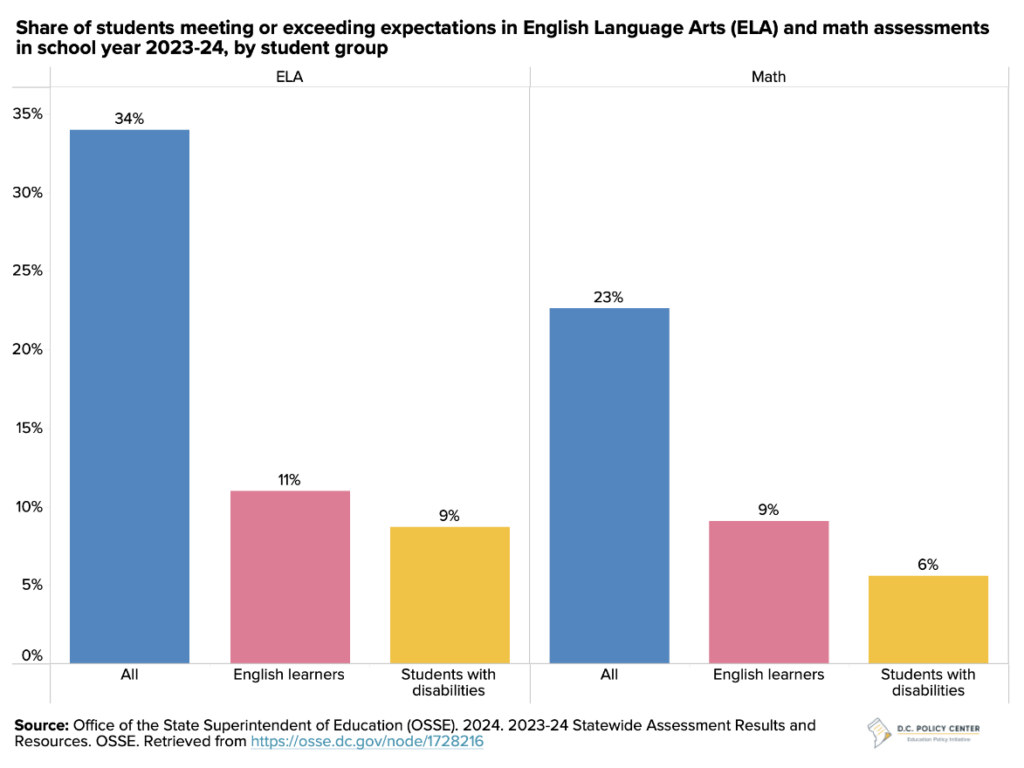
On Tuesday, October 29, 2024, Senior Education Research Analyst Hannah Mason testified before the D.C. Council Committee of the Whole at its teacher and principal retention hearing. Her testimony focuses on the comparison of teacher retention across urban districts and the share of new teachers and vacant positions by subject and specialization. You can read her testimony below, or download a PDF copy.
Urban districts tend to have lower teacher retention than other areas. In school year 2021-22, for example, teacher turnover was the highest (12 to 14 percent) in urban districts, high-poverty districts, and districts predominately serving students of color.1 One study across nine large urban school districts showed that, between October 2022 and October 2023, schools serving greater numbers of students experiencing poverty lost 29 percent of their teachers.2 Additionally, 39 percent of teachers who moved between school year 2022-23 and 2023-24 moved to a school within the same district with fewer students living in poverty.3
D.C. had teacher retention rates in school year 2023-24 on par with surrounding districts while serving a similar share of economically disadvantaged students.4 Overall, 83 percent of teachers were retained in D.C.5 For example, in Baltimore, 83 percent of teachers were retained,6 and 72 percent of students were identified as economically disadvantaged.7

Teacher retention is important for many reasons, in part because it means schools have to hire educators to replace any who leave every year. And some subjects or specializations are harder to hire than others. Special education teachers, for example, have the highest vacancy rates in the fall (at 8 percent in the fall of 2023, for example), and the second lowest percent of teachers returning to the same role, same school, and same grade band by subject at 63 percent (61 percent of CTE teachers return, at the lowest rate). In math and English Language Arts (ELA), less than 70 percent of teachers are returning. It is slightly harder to hire for math teachers than ELA teachers at 4 percent of positions remaining vacant by the fall. English as a second language teachers are more likely to return, at 74 percent returning.8

Pandemic recovery in achievement has also been tough in some of these subject areas, especially math and for students with disabilities. D.C. should focus retention efforts to recruit and retain these teachers in these high need subjects and train up new ones—for example, implementing the proposed mathematics education improvement act is a starting point to ensure research-based curriculum and intervention for struggling students is provided to schools and a catalogue of professional development and resources that focuses on foundational content knowledge is available.9

In addition to addressing teacher retention rates by subject and specialization, there are important differences by student group. In general, Black and Latino students are disproportionately taught by inexperienced and uncertified teachers.10 This is especially important because teacher retention rates tend to be lower in higher-poverty schools11 which serve more vulnerable populations. By focusing on teacher retention by subject group in addition to subject and specialization, D.C. can continue improving our education systems and strengthen outcomes for all students.
Endnotes
- Diliberti, M., & Schwartz, H. 2023. Educator turnover has markedly increased, but districts have taken action to boost teacher ranks. Rand. Retrieved from https://www.rand.org/pubs/research_reports/RRA956-14.html
- Education Resource Strategies (ERS). 2024. “Examining School-Level Teacher Turnover Trends from 2021 to 2023: A New Angle on a Pervasive Issue.” ERS. Retrieved from https://www.erstrategies.org/tap/teacher-turnover-trends-analysis/
- Education Resource Strategies (ERS). 2024. “Examining School-Level Teacher Turnover Trends from 2021 to 2023: A New Angle on a Pervasive Issue.” ERS. Retrieved from https://www.erstrategies.org/tap/teacher-turnover-trends-analysis/
- 49 percent of students in D.C. were designated at-risk in school year 2023-24.
- Office of the State Superintendent of Education (OSSE). 2024. “2023-24 District of Columbia Educator Retention Brief.” OSSE. Retrieved from https://osse.dc.gov/sites/default/files/dc/sites/osse/page_content/attachments/2024%20ERB.pdf
- Maryland State Department of Education. 2024. Maryland’s Teacher Workforce: Supply, Demand, and Diversity. State Department of Education. Retrieved from https://marylandpublicschools.org/stateboard/Documents/2024/0521/Maryland-Teacher-Workforce-Supply-Demand-and-Diversity-A.pdf
- Maryland State Department of Education. 2024. “Student Group Populations Data.” State Department of Education. Retrieved from https://reportcard.msde.maryland.gov/Graphs/#/Demographics/StudentPopulation/1/1/30/XXXX/2024
- Office of the State Superintendent of Education (OSSE). 2024. “2023-24 District of Columbia Educator Retention Brief.” OSSE. Retrieved from https://osse.dc.gov/sites/default/files/dc/sites/osse/page_content/attachments/2024%20ERB.pdf
- Mathematics Education Improvement Amendment Act of 2024, B25-0800. (2024). https://lims.dccouncil.gov/downloads/LIMS/55307/Introduction/B25-0800-Introduction.pdf?Id=189465
- Mehrotra, S., Morgan, I., & Socol, A. 2021. Getting Black Students Better Access to Non-Novice Teachers. EdTrust. Retrieved from https://edtrust.org/wp-content/uploads/2014/09/Getting-Black-Students-Better-Access-to-Non-Novice-Teachers-December-2021.pdf ; Mehrotra, S., Morgan, I., & Socol, A. 2021. Getting Latino Students Better Access to Non-Novice Teachers. EdTrust. Retrieved from https://edtrust.org/wp-content/uploads/2014/09/Getting-Latino-Students-Better-Access-to-Non-Novice-Teachers-December-2021.pdf
- Garcia, E., & Weiss, E. 2019. U.S. schools struggle to hire and retain teachers. Economic Policy Institute. Retrieved from https://www.epi.org/publication/u-s-schools-struggle-to-hire-and-retain-teachers-the-second-report-in-the-perfect-storm-in-the-teacher-labor-market-series/
